Baking instruments
© Satu Hovi 1998 / 2017
No part of this text is allowed to be cited or published without my permission. Please note that methods of research get better all the time, and new interpretations may appear.
Wood tub
The dough was mixed and leavened in a a wooden tub (Uusivirta). The leavening tub should never be washed; the dough leftovers are left to dry in it. On the next baking day the liquid added to the tub makes the dry dough leftovers soft, and the souring of the next dough starts. The tub was stored in a cool place when not in use. If it stays in too warm a place, the pieces of the wooden tub brake apart. When you wet it again for the next baking session, all the dry leaven leftover will dissolve into the water. Never wash wooden tub with industrial washing powders; their taste will stay in the tub! If the tub is musty, fill it with hot, boiling water and add juniper leaves into the water. Better if you have had time to boil the leaves in the water for some time before adding them to your baking tube. Let it stay in for some time.
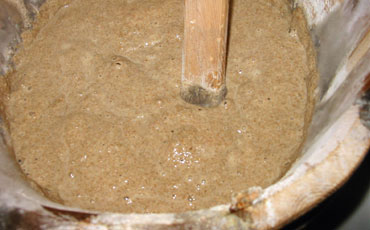
Perforators
In ancient times it was normal to decorate the bread loaves or cover them with small holes before baking. It prevented the breaking of the surface. The small holes helped the bread to dry quickly and not to go musty. Israelsson writes that the Vikings tied feathers together and made the small holes with them. In folk tradition some kind of blessing were to be given to the bread by drawing a cross on the top of the loaf with a knife. That might come from the uncertainty of the next year’s bread.
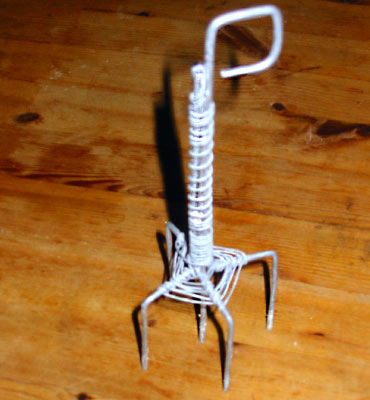
Dough mixer
Dough mixer (härkin in Finnish), was made from the top of the pine tree. A suitable tree had a top formed by four or five sticks on the same height from about an arms length down from the top. The top was cut straight under the upper bough and peeled. The arm had to fit to the size of the tub; the mixing of a leaven is hard, so the arm has to be just long enough to ease the work.
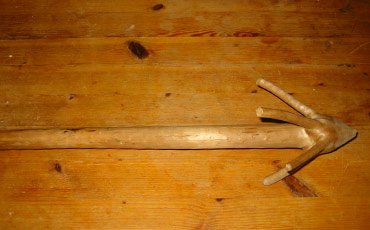
Hole maker
If the loaves are to be dried, they need to have a hole. According to the Viking age bread finds from Sweden the hole was not in the middle of the loaf, as it always is nowadays. It was a little towards the perimeter (Wiklund).
Traditionally the hole was made with a cow horn when forming the dough into loaves (pictures in Uusivirta). To dry the loaves, a thin pole was thrust through the hole and the pole was hung horizontally near the ceiling.
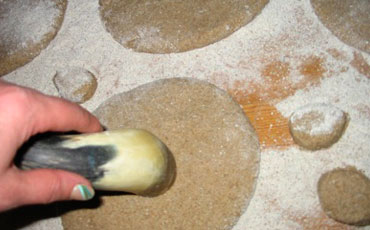
Baking board
The baking board was brought into the house only on baking days and was never used for any other purposes . This way the loaves could raise in peace on top of it. After use the flour was cleaned from the board by the paw of a hare which, according to my grandmother, indeed still is the best tool for the job, and the board carried back to storage.
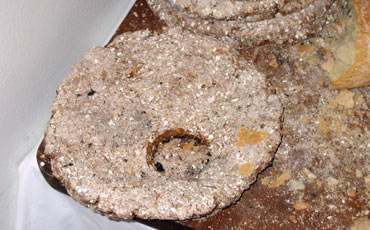
Beater
A beater made from a bare twig could be used when adding the very first flour to the liquid. By beating the mixiture some air was let in to it to make a better bread. The beater was made in the spring from a young birch or willow, when its bark could easily be taken out.
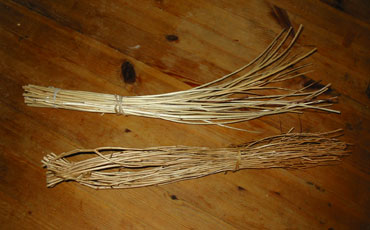
Bibliography
Aaltonen, Turkka & Arkko, Matti: Yrttiopas, luonnonkasvit ravintona. Suomen matkailuliitto, 1986
Berger, Christian & DuboË- Laurence. Philippe: Oluen ystävän opas.Otava
Birkebaek: Oldtiden I, Vikingatiden.
Blamey, Marjorie & Grey-Wilson, Christopher: Otavan kasvitieto. Skotlanti, 1994
Dembinska, Maria: Food and Drink in Medieval Poland. University of Pennysylvania press, 1999
Genrup, Kurt: Mat som Kultur; Etnologiska kosthållstudier. Tidskrift för nordskandinavisk etnologi vol 5, Umeå Universitet 1988
Hagen, Ann: a Handbook of Anglo-Saxon Food, Processing and Consumption. Anglo-Saxon books, 1994
Hagen, Ann: a Handbook of Anglo-Saxon food, Production & Distribution. Anglo-Saxon books, 1995
Hess, Karen: Martha Washington’s Booke of Cookery. Columbia University Press, 1981
Israelsson, Isse: Mat på forntida vis, ide och receptsamling; Malmö museer (also published in Forntida teknik 2/89-1/90 as Forntida mat)
Johansson, Tomas: Att ätä som en stenåldersjägare; Forntida Teknik
Jäntti & Olkinuora: Tähkäpää, luomuleipojan käsikirja
Kulturhistorisk lexikon för nordisk medeltid; Akademiska bokhandeln 1976
Kytövuori, Pirjo & Hopsu-Neuvonen, Arja: Kanankaalista karpaloon, luonnonruokaa keväästä syksyyn. Marttaliitto ry 1995
Lampinen: Ruokaleipä ja sen valmistus
Moberg; Min svenska historia, det dagliga barkbrödet
Namez, Milton: Searching for a Structure in the Late Iron Age Settlement of the Åland Islands, Finland, Karhunhammas 15/1993
Rautavaara, Tapio; Mihin kasvimme kelpaavat, ruokaa, ryytiä ja rohtoa luonnosta, WSOY 1976
Retkeilykasvio. Suomen luonnonsuojelun tuki oy. Helsinki, 1984
Rousi, Arne: Auringonkukasta viiniköynnökseen, ravintokasvit, WSOY 1997
Sass, Lorna: Christmas Feasts from History.The Metropolitan Museum of Art, 1981
Schöneck, Annelies: Leipä, Hermes Oy, 1983
Seppä-Heikka, Merja: Esihistoriallisia siemeniä ja kasvipainanteita Paimion Sievolan myöhäisrautakautiselta asuinpaikalta.
Simonetti, Gualtiero: Makujen maailma, yrtit ja mausteet. Kolibri, 1990
Stead, Bourke ja Brothwell: Lindow Man the Body in the Bog; British Museum Publications, 1986
Storck, John & Teague, Walter Dorwin: Flour For Man’s Bread; A History of milling. Oxford University Press, 1952
Suominen, Juha & Hämet-Ahti, Leena: Kasvistomme muinaistulokkaat, tulkintaa ja perusteluja, Vammala 1993
Thunaeus, Harald: Mjödet genom tiderna. Daedalus 1954
Tolonen, Mirjami: Cereal Cultivation with Particular Reference to Rye: Some Aspects on Pollen-analytical Records from Sw. Finland; Fennoscandia Archaelogica II, Suomen arkeologinen seura, 1985
Uusivirta, Hilkka: Suomalaisen ruokaperinteen keittokirja, WSOY 1982
Vehviläinen, Olli: Hiivan tarina
Viklund, Karin: Bröd, gröt och öl i forntiden; Aktuellt 93, Forntida teknik 1/93
Wilson, Anne C.: Food and Drink in Britain From the Stone Age to recent times.Penquin Books, 1084
Articles:
Bengtsson, Niklas: Elämän ja kuoleman eliksiirejä. HS 3.4.1997
Mannerkorpi, Jukka: Hunajaleipuri johtaa onneen; HS 3
Masonen, Jaakko: Maistui olut ennenkin. Tiede 2000 4/1992
Mausteet ehkäisevät homehtumista, Pirkka 1-2/96
Pakarinen, Aila: Kaalin hapattaminen sujuu aloittelijalta. HS
Skaarup, Bi: Sources of Medieval Cuisine in Denmark. In: Du manuscrit à la table, direct. Carole Lambert. Canada, 1992
Suomalaisille tarjotaan jälleen nälkämaan leipää; Itä-Helsingin Uutiset 27.3.1993
Tahkolahti, Jaakko: Pettu onkin terveellistä ja torjuu myös UV-säteilyn; HS 11.2.1997
Toiviainen, Lauri: Oluenpanosta todisteita jo 5000 vuoden takaa. HS 5.12.1992
Uudelleen keksitty pellava maustaa lakritsin ja sämpylän; HS 17.11.1994
HS= Helsingin Sanomat
Classes:
Vilkuna, Anna-Maija: Ruokatalous Hämeen linnassa 1500-luvulla. (Food Consumption in 16th century Häme castle) Suomen muinaismuistoyhdistys 4.12.1997
Conversations:
Linturi, Elsa. Archaeologist, University of Helsinki